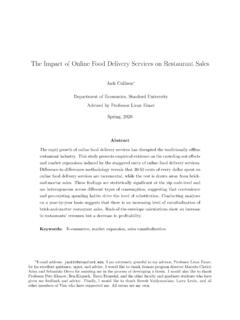Transcription of Success Story of a Start-up A Case Study of OLA Cabs
1 IOSR Journal of Business and Management (IOSR-JBM). e-ISSN: 2278-487X, p-ISSN: 2319-7668. Volume 20, Issue 2. Ver. II (February. 2018), PP 30-37. Success Story of a Start-up A Case Study of OLA Cabs 1. Dr. Ashok Kumar Panigrahi,2 ShambhaviShahi,3 AmarsinghRathore 1. Associate Professor in Finance,School of Pharmacy & Technology Management,NMIMS University, Shirpur. 2. MBA (Pharm Tech 3rd Year), School of Pharmacy & Technology Management,NMIMS University, Shirpur. 3. MBA (Pharm Tech 3rd Year), School of Pharmacy & Technology Management,NMIMS University, Shirpur. Corresponding Author:1Dr. Ashok Kumar Panigrahi Abstract:"Start-ups don't die, they commit suicide. In other words, 90 percent of start-ups fail because the founders get bored, discouraged, or something else, and they move on to other things, not because of some catastrophe. No matter how dark it is today, things will always better tomorrow.
2 " -- Justin Kan, businesses have always played an important role in the global economy, but recently their importance has grown significantly. For this reason, governments around the world have amended regulation and created incentives to encourage their development. However, statistics shows that startups have an extremely high mortality rate, often due to a lack of strategic planning, wrong marketing investments or inefficient resource allocation. This paper is the Success Story of an Indian startup, Ola Cabs. As the competition in the Radio Taxi market is increasing at a very faster rate where several brands are providing cabs to the customers as per the requirements, this paper is designed to Study the Success Story of Ola cabs which has the greatest market share and provides services in an efficient manner along with customer satisfaction. The Marketing strategy and promotion strategy adopted by Ola Cabs is discussed briefly in this article.
3 Keywords: Start-up , promotional strategy, Ola cabs, Taxi aggregator. ---------------------------------------- ---------------------------------------- ---------------------------------------- ----- ---------- Date of Submission: 25-01-2018 Date of acceptance: 12-02-2018. ---------------------------------------- ---------------------------------------- ---------------------------------------- ----- -------- I. Introduction Managing and growing a successful startup is ripe with challenges from all sides from keeping employees and investors happy, to raising money and constantly improving your bottom every Start-up is bound for Success . In actuality, getting money from an investor is no easy feat, but when you know what states are the most investor friendly, what investors are looking for and how to build a powerful team around your organization -- then you are much more likely to find Start-up , more popularly known as Ola, is just like any other marketplaces online, but more specifically into providing Taxi services.
4 Ola, which started as an online cab aggregator in Mumbai, now resides in the Silicon Valley of India Bangalore, and is also known to be one of the fastest growing businesses in India, out-beating its competitors Uber & Meru. Coming back to the man behind Ola; simple yet charming Bhavish, with the Success of his prodigy has certainly become the talk of the town. But even after becoming a millionaire, he still prefers to not buy a car and take a cab (to set an example, we presume), certainly doesn't goes down well with his wife. He believes that, such is a small price that every entrepreneur has to pay. Taxi Services in India The middle class population in India rose from 15 million in 1991 to160 million in 2011. This segment with its increasing disposable incomestarted demanding and has been willing to pay for better servicesacross sectors including private and public transportation.
5 Rapideconomic growth coupled with huge infrastructure development,rigorous effort from Ministry of Tourism to project India as traveldestination and emergence of Business Process Outsourcing (BPO)industry has given a huge push to the car rental industry in India. Till2003, the point-to-point taxi market in India's big metropolitan citieswas completely unorganized. It was served either by unorganized,inconsistent and somewhat expensive private operators or by stategovernment controlled pre- paid taxis offering a standardized but lowquality service. But in 2003 the Radio cabs business emerged as oneof the fastest growing businesses in the Indian transportation sectorwith Delhi-based Mega Corp setting the wheels rolling under the MegaCabs brand in cities such as Bangalore, Mumbai, Calcutta, Chandigarh,Ludhiana and Amritsar. Today, 15,000 plus professionalized air-conditionedtaxis are available to customers in 6 big cities in a largelyreliable, convenient and affordable manner (Rahman & Anand, 2014).
6 DOI: 30 | Page Success Story of a Start-up A Case Study of OLA Cabs Indian Taxi Market: The taxi market scenario in India is hugely fragmented. The taxi market in India is divided into two major segments which are the organized and unorganized markets. The unorganized market has a market value of $ billion and the organized market holds a market value of almost $500 million. The organized sector is the recently emerged segment in the market scenario. It is further classified into owners, affiliators and aggregators. The owned vehicle segment is inclusive of the pure car rentall companies like meru. The affliators are accomplished with multiple car rental agencies and they are known to provide different tour packages or deals. Whereas the aggregator are the newest phenomenon which are driven by start ups like ola cabs. Market Share of IndianTaxi Market 7%.
7 23% unorganized affiliators aggregators 60%. owners 10%. Due to the increse in competiton and a steep rise in public demand due to the quality and comfort of service provided by these taxi services there has been an increase in the investment activity for the the interim, big cash is making this fight worth battling for. As indicated by the Association of Radio Taxi India, the taxi business in the nation is developing at 20 to 25 for each penny a year. The sorted out taxi area represents only four to five for every penny of the business and sums $800 million. It is relied upon to develop to $7 billion by central government, vide its budget 2015-16 has now clearly defined the term aggregator: Aggregator means a person, who owns and manages a Web-based software application, and by means of the application and a communication device, enables a potential customer to connect with persons providing service of a particular kind under the brand name or trade name of the aggregator.
8 Indian taxi market is assessed to be around $8 billion (Rs 48,000 crore) at this moment, out of which just 5% is being overseen under sorted out area; which implies that the market is completely open right at this point. It is being anticipated that in the following 5 years, sorted out players, for example, Uber, Meru and Ola will catch 15% of this market, which is developing at an astonishing rate of 45% every year. The Indian cab market has seen a lot of traction, with over INR 600 crores being raised by the leading players in the sector. While this has been a very competitive market, the organized sector forms a small percentage of the overall market. It is estimated that the radio taxi market in India is $6-9 billion dollars growing at 17-20%. It is also estimated that the number of taxis in the organized sector will reach 30,000 by 2017. The sector has in the past few years seen tremendous growth with nearly 10 fairly large companies operating in various models.
9 But even in this clutter, three companies stand out in their product uniqueness, customer service responsiveness, driver behaviour and timely arrivals Olacabs, TaxiForSure and the global sharing economy pioneer, Uber. Other companies that are operating include Meru, Easy Cabs, Savaari and BookMyCab. The market made a transition from owned fleet to a fleet aggregator model where anyone could own a car and become an entrepreneur in fact, Ola Cabs conducted a Driver Mela in Pune and Bangalore to get vehicles at a discount to potential drivers. As well as aggregators are coming up with lots of attractive schemes and plans for drivers and to lure their customers by getting different schemes to drivers from the manufacturers like OlaCabs did Driver Mela in Pune DOI: 31 | Page Success Story of a Start-up A Case Study of OLA Cabs and Bangalore, TaxiForSure came up with Magic Trip on their Mobile Application, Uber comes up with different promo code from time to time.
10 OLA Company profile: Ola initially started off as a small website venture that offered weekend trip packages. It was started as astartup business by two IIT Mumbai graduates Bhavish Aggarwal and Ankit Bhati. Bhavish worked for Microsoft after college for almost two years and then started a small website to sell online tour packages. Due to a bad experience during a car rental situation they decided to mend the system of car rental and this became the basis for the initiation of olacabs. Olacabs are now referred as Ola. Ola is a Spanish term which means hello! This indicates that hiring a cab at Ola as well as the services provided are easy and friendly as conveying hello. Ola cabs were founded on 3 December 2010 by Bhavish Aggarwal and Ankit Bhati. Initially Ola operated from Mumbai as a taxi aggregator service. Now it has shifted its head office at Bengaluru and works efficiently from there.











